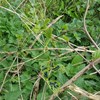The Alder Leaf Beetle - Agelastica alni (L.)

Observatree Volunteer
In 2011, I planted a wood containing many Alders, and after a few years I noticed little blue beetles eating the leaves. By 2018 they were so frequent that I decided to look up what they were and discovered that they were Alder Leaf Beetle (ALB). I sent in a TreeAlert report but was informed that the beetle is not regarded as a significant problem. Upon sharing the photos of the beetles at an online meeting of Observatree volunteers, several attendees were unfamiliar with ALB. But once these volunteers started to look for them, many found the beetles in their local areas. Pole stage trees were defoliated by June while eggs could still be found, and some beetles could be seen into September. I became concerned with the potential for a second generation. Forest research say there is no evidence for a second generation on the continent where it is widespread and not normally problematic, as the defoliated trees do reflush. In 2021, when we had a high-pressure system over the country, and cold clear nights with warm sunny days through March and April, the beetles became active several weeks before the Alders flushed and were seen feeding on Hazel, Birch, Hawthorn, Cherry Plum and just about anything else that was green. This year their waking up coincided with bud burst on Alders.
Back in the spring I counted as many as 42 beetles on a horizontal Common Alder shoot from a 3-year-old coppice stool (pictured above). Most of the wood was flooded at least once over the winter period so many of the beetles, which hibernate in leaf litter, will have probably died.
After hibernation they feed on Alder leaves but are also partial to birch, which I have seen larvae feeding on. Gravid (egg-filled) females can be distinguished by their distended yellow /orange abdomens. The yellow eggs are laid on the underside of the leaves and hatch after around two weeks.
The first instar are yellow and feed together on the underside of the leaves. The second instar are also gregarious while they do separate out in the final instar. They eat either the top or bottom surface of the leaf but not both, sometimes the entire upper or lower side of the leaf may be removed. They pupate in the litter layer or probably any sheltered crevice, and the adults emerge relatively quickly so adults can be found throughout the year. Then they shelter during a period of inactivity known as diapause during the heat of the summer before feeding up and hibernating again in the leaf litter. On my light soil they manage to bury themselves shallowly, but they are also fond of the gap between spiral tree guards and a tree trunk.
In comparison with these photos, I have not seen any gravid females yet this year.
The beetle was previously considered native but then declared extinct in U.K, until it was found in Manchester in 2004. Since then, it has spread quickly on a local level. It can certainly reproduce prolifically and when it is warm the air can be filled with flying beetles. I often find them in the car and on my clothes when I get home in the spring.
Its history in Britain is interesting and worth summarising. The following is an excerpt from A History of Agelastica Alni (L) (Coleoptera: Chrysomelidae) in the British Isles, by Don A, Steinhouse, from the Entomologist’s Monthly Magazine in February 2019.
“There are Alder leaf beetles in the Bronze Age deposits of Flag Fen, so there is no doubt about it being native. Prehistoric archaeological evidence comes from several sites, in the South and East of England and one from the Bristol Channel coast of Wales. There appears to be no evidence for it after Iron Age deposits until the start of the 19th Century. 19th and 20th century records are occasional at best and limited to the south and coasts. Historical records are very infrequent, surprising for an easily recognisable obvious beetle if genuinely native. There has long been a debate about whether ALB was/is native or a visitor. The last 20th century record appears to be from Dorset in 1958.
The first UK 21st century record is from Manchester in 2004, this was followed by an increasing number of sightings across an ever-expanding area. A similar spread was seen after ALB was recorded on the south coast in Hampshire in 2014.”
Whilst ALB is not considered to be a significant threat to Britain’s trees at this time, reports of the beetle are welcome through TreeAlert to support the monitoring, spread and population density of the insect.
